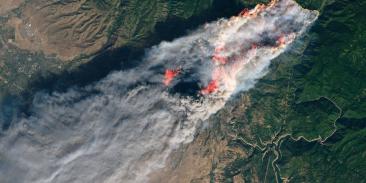Dayton & Montgomery County Receive A D Grade For Air Quality And An A- For Drinking Water In New Environmental Report Card
| Issue | Grade | Explanation |
| Drinking Water | A- | The Dayton Water Department gets very high marks for ensuring clean drinking water, especially its Well Field Protection Program’s efforts to prevent groundwater contamination. However, one-third of county residents are served by smaller water systems that have a history of not meeting federal health standards. |
| Rivers and Streams | B | On the plus side, separated sewers in the county help to prevent untreated sewage from getting into local streams. However, 98 facilities are permitted to discharge pollutants directly into local streams, with 13of those classified as “major” facilities-a sizable number for any area. |
| Air Quality | D | Air quality just barely meets federal ozone standards today, and based on recent trends will likely fail to meet them within the next few years. Also, the county ranks among the worst 10% of US counties for added cancer and non-cancer risks due to hazardous air pollutants from automobiles as well as industrial sources. |
“Montgomery County’s smog, mostly from automobiles and trucks, raise genuine concerns about the potential air quality impacts of the proposed I-892 outer beltway and changes to I-75,” said Jane Forrest Redfern, environmental projects director for Ohio Citizen Action. “More roads mean more cars, which means more smog that can cause asthma and other respiratory problems. Rather than building more roads, the city and county should be focusing on ways to reduce emissions by encouraging residents to drive less or use cleaner cars.”
“Dayton’s pioneering work to prevent contamination of its drinking water source is a model for other communities in the county and elsewhere,” said Carol Andress, economic development specialist for Environmental Defense. “Continuing this effort, and encouraging other, smaller systems to follow Dayton’s lead is vital to the area’s livability-once contaminated, groundwater is exceedingly difficult and costly to clean.”
With more than 3 million members, Environmental Defense Fund creates transformational solutions to the most serious environmental problems. To do so, EDF links science, economics, law, and innovative private-sector partnerships to turn solutions into action. edf.org
Latest press releases
-
Groups File Lawsuit Challenging Trump EPA’s Delay of Protections Against Oil and Gas Methane Pollution
July 31, 2025 -
New study shows how sectoral emissions shape today’s warming and tomorrow’s risks
July 30, 2025 -
EPA Administrator Zeldin Delays Commonsense Methane Pollution Protections
July 29, 2025 -
NEW: U.S. Government’s Own Analysis Shows Repealing Tailpipe Pollution Standards Will Sharply Increase Gasoline Prices
July 29, 2025 -
Trump Administration Tries to Eliminate Endangerment Finding, Clean Car and Clean Truck Standards
July 29, 2025 -
Illinois Approves Electric Rate Encouraging Use of Clean Affordable Energy
July 28, 2025










